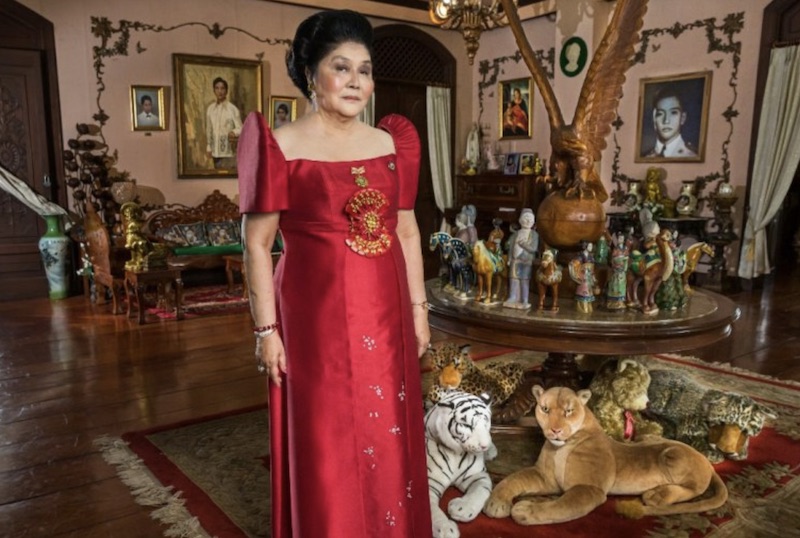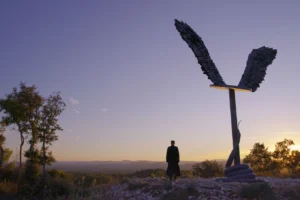In ‘The Kingmaker,’ Sordid Past is Prelude
Filmmaker Lauren Greenfield looks at Imelda Marcos then and now, older but still toxic. Imelda Marcos in "The Kingmaker." (IMDb)
Imelda Marcos in "The Kingmaker." (IMDb)
In the Philippines, there is an island called Calauit, a tropical refuge populated by farmers until 1977, when it was overtaken by 104 beasts imported from Kenya, including giraffes, zebra and gazelle, all part of first lady Imelda Marcos’ private menagerie, which displaced 256 families. Marcos aimed to nurture her personal Garden of Eden as she would her country, and the results are revealing. Neglected for 40 years, the animals of Calauit Island are inbred and ailing. The villagers, like 21% in the rest of the country, live in poverty.
Calauit is the jumping-off point for filmmaker Lauren Greenfield’s new documentary, “The Kingmaker,” which opens in theaters Friday. Greenfield is famous for such chronicles of conspicuous consumption as “The Queen of Versailles,” about Jacqueline and timeshare king David Siegel’s effort to build the largest home in the U.S. during the recession, and “Generation Wealth,” about Greenfield’s rich-kid classmates at Santa Monica’s exclusive Crossroads School.
While “The Kingmaker” features interviews with animal handlers and archival footage of the beasts being shipped to and arriving at Calauit, its focus is on a different kind of predator in a different kind of jungle: Imelda Marcos, in her own words, sitting amid priceless works of art, lamenting her fate. The film is about a sordid past, in which she and her husband, President Ferdinand Marcos, are accused of looting an estimated $5 billion to $10 billion from their country, as well as staining their hands with the blood of thousands of activists, including that of opposition leader Benigno Aquino, who was assassinated in 1983. Even more chilling, “The Kingmaker” is also about the return of the Marcos family to political power.
“She’s unguarded. She speaks her mind all the time, and that could come from the fact that she’s never had to face accountability. I was really afraid to ask her about the assassination of Benigno Aquino, but I kind of worked up to it,” Greenfield tells Truthdig, noting that Marcos put no limits on the questions she could ask. “When I asked her, she said, without missing a beat, ‘Why would I do that? I have nothing against him except that he talks too much.’ ”
The first half of the movie provides background: the death of her mother during her childhood, volatility in the family fortunes, her disputed victory in the 1953 Miss Manila beauty pageant, and her 11-day whirlwind courtship with then-Sen. Marcos before their marriage a year later. The film’s second half examines Marcos’ real-time efforts to restore her family to power after being driven from the country in the 1986 “People Power Revolution,” which brought Aquino’s widow, Corazon, to the presidency.
“What we know is in the film … [current President Rodrigo] Duterte says he got money from Imee Marcos, but they did not contribute officially,” Greenfield says about a clip that shows Duterte at a news conference acknowledging receiving funds from Sen. Imee Marcos, Imelda’s daughter. Also running in the 2016 election that put Duterte in power was Marcos’ son, vice presidential candidate Ferdinand Jr., known as Bongbong. Candidates for president and vice president are decided separately, and Bongbong lost out to opposition candidate Leni Robredo, whom Duterte has disavowed, charging her with sedition in July in an attempt to have her removed.
Bongbong has contested election results in the Supreme Court, where Duterte replaced Chief Justice Maria Lourdes Sereno with the more Marcos-sympathetic Lucas Bersamin in an attempt to clear the way, though the court remains undecided. Duterte spokesman Harry Roque is quoted as saying the strongman, responsible for a reported 12,000 deaths in his “war on drugs,” has a “real, genuine wish to step down” if a qualified leader could replace him, singling out Bongbong as a successor.
Following her husband’s death in 1989, Imelda Marcos was left to face down racketeering, conspiracy, fraud and obstruction of justice charges in the U.S. on her own. She was acquitted of all counts in 1990 and returned to the Philippines, her criminal past seemingly forgiven. She was soon running for office, winning a congressional seat and representing her home province of Leyte in 1995, leaving opposition activists of a certain age aghast. They recall that after the first term of the Marcos presidency, he refused to step down, instead instituting nine years of martial law, during which the government imprisoned 70,000 people, tortured 34,000 and killed 3,240, according to Amnesty International.
In “The Kingmaker,” activists recall torture and rape at the hands of police, and how San Juanico Bridge, dubbed the “bridge of love” and built at exorbitant expense as a birthday gift to Imelda early in her marriage, became a favorite place for executions. In the meantime, Marcos has been using her influence to rewrite history. Children are heard saying that martial law made the country safer. “Perception is real, truth is not,” Marcos intones, something Trump might say, if he knew the word “perception.”
“She becomes very dependent and addicted to this constant love by the people, which I think is part of what drives her to want to come back to power,” Greenfield says.
In 2010, Marcos replaced Bongbong, who successfully campaigned for senator. Daughter Imee is currently a senator, grandson Matthew Manotoc is governor of Ilocos Norte (the Marcos seat of power), and even Bongbong’s son, Alexander, or “Sandro,” is getting into the act, eyeballing the vice-gubernatorial post in the same state as recently as March.
Critics accuse the Marcos family of funding its political endeavors with assets pillaged from the Filipino people decades earlier. Under Corazon Aquino, the PCGG (Presidential Commission on Good Government) was established in 1986 with the express purpose of recovering “ill-gotten wealth of the Marcoses goods and valuables and returning the money to the people.” To date, roughly $3.4 billion has been recovered, leaving another $4 billion spread among shady deals, art assets and money-laundering schemes, such as the house she put in the name of actor George Hamilton, which he later turned around and sold for his own profit. Since Duterte has gained office, Juan Andrés Bautista, head of PCGG under his predecessor, Noynoy Aquino (Benigno Jr.), has been removed, though the office has survived efforts to have it shuttered altogether.
“I don’t think she started out as a villain. She talks about Moammar Gadhafi, Saddam Hussein, Chairman Mao, as being her friends, being wonderful people. It’s all personal with her. She says, ‘I don’t read books about the leaders I’m going to meet,’ which is maybe a commonality she does have with Trump. She doesn’t do research; she bases it all on personal connections. So, if they’re nice to her, they’re good people,” Greenfield says. “I think with Aquino it’s very personal. She’ll talk about Noynoy and Cory in very personal terms. I don’t think it is as personal on the other side.”
Duterte is part of a global wave of strongmen who have come to power in recent years and exploited economic anxieties, racism and fear. Under Aquino, the country reformed its constitution and adopted more democratic values, but the poverty level continued to grow.
Bongbong represents a new generation of the Marcos family. But it’s easy to see that the apple doesn’t fall far from the tree when he laments how humiliating it would be to return to his country flying in coach. As Bongbong ascends, Benigno Aquino’s admonition to his son, Noynoy, resonates: You can’t really have democracy while people are hungry, and that’s why it’s so important to bring up the standard of living.
Your support matters…Independent journalism is under threat and overshadowed by heavily funded mainstream media.
You can help level the playing field. Become a member.
Your tax-deductible contribution keeps us digging beneath the headlines to give you thought-provoking, investigative reporting and analysis that unearths what's really happening- without compromise.
Give today to support our courageous, independent journalists.






You need to be a supporter to comment.
There are currently no responses to this article.
Be the first to respond.